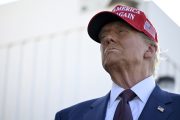
President Trump withdrew the United States from the 12-nation TPP in 2017, fulfilling one of his most important presidential campaign promises.
The 11 remaining countries agreed to an amended version of the trade agreement, now called the Comprehensive and Progressive Agreement for Trans-Pacific Partnership (CPTPP) last November, signing it this past March. The new TPP will take effect once six of its members ratify it.
Back on April 12, Trump’s supporters were alarmed when he ordered top officials to look at rejoining the trade pact. The Washington Post quoted Senator John Thune (R-S.D.), who said Trump told U.S. Trade Representative Robert Lighthizer and National Economic Council Director Larry Kudlow to “take a look at getting us back into [the TPP], on our terms, of course.”
Kudlow told reporters that the United States is “in the pre-preliminary stages of any discussions” with TPP countries about rejoining the pact, but noted that the prospect of reentry was more a “thought” than a “policy.”
However, on April 17, after a dinner with Japanese prime minister Shinzo Abe, Trump appeared to have reconsidered, tweeting:
While Japan and South Korea would like us to go back into TPP, I don’t like the deal for the United States. Too many contingencies and no way to get out if it doesn’t work. Bilateral deals are far more efficient, profitable and better for OUR workers. Look how bad WTO is to U.S.
Those who voted for Trump because he was so opposed to U.S. participant in the TPP were relieved — providing he does not change his position once more.
An article in The New American on April 13 noted any U.S. move to rejoin the TPP, which China has shown interest in joining, would be a steppingstone to increase China’s clout. The article noted:
The truth is that both China and the United States are members of APEC [Asia Pacific Economic Cooperation]. The fact that China won endorsement for the FTAAP [Free Trade Area of the Asia-Pacific] as a “long-term goal” at the 2014 APEC summit demonstrates the United States’ willingness to abrogate its sovereignty and to economically integrate the United States with Communist China and Russia in a future Trans-Pacific Union based out of Beijing.
U.S. reentry and passage of the TPP/CPTPP would be a major step toward the realization of APEC’s vision for the Free Trade Area of the Asia Pacific and an eventual Trans-Pacific Union, eroding the remaining vestiges of U.S. sovereignty and independence.
Note: This article was revised to reflect the fact that President Trump’s decision to have top administration officials look at the possibility of rejoining the TPP was short-lived.
Related articles:
Trans-Pacific Partnership to Facilitate U.S.-China Merger
Congress Can Stop the NAFTA Redo by Nixing TPA Renewal
Goal of TPP: Free Trade Area of the Asia Pacific (FTAAP)
Regional Scheme for the Pacific Rim
Trans-Pacific Partnership (TPP): Bigger and More Dangerous Than ObamaCare (Video)
Trans-Pacific Partnership (NAFTA on Steroids) Threatens Sovereignty




